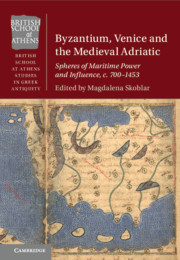Book contents
- Byzantium, Venice and the Medieval Adriatic
- British School at Athens Studies in Greek Antiquity
- Byzantium, Venice and the Medieval Adriatic
- Copyright page
- Contents
- Figures and Maps
- Tables
- Contributors
- Foreword
- Acknowledgements
- Note on Citation, Transliteration, Names, Titles and Dates
- Maps
- Introduction
- 1 The Adriatic Sea 500–1100
- 2 Thinking of Linking
- 3 A Winter Sea?
- 4 The Origins of Venice
- 5 The Northern Adriatic Area between the Eighth and the Ninth Century
- 6 Provincia Iadrensis
- 7 Ravenna and Other Early Rivals of Venice
- 8 Byzantine Apulia
- 9 From One Coast to Another and Beyond
- 10 Icons in the Adriatic before the Sack of Constantinople in 1204
- 11 The Rise of the Adriatic in the Age of the Crusades
- 12 Venice in the Twelfth Century
- 13 Venice, the Ionian Sea and the Southern Adriatic after the Fourth Crusade
- 14 Sea Power and the Evolution of Venetian Crusading
- 15 Reassessing the Venetian Presence in the Late Medieval Eastern Adriatic
- 16 ‘Strangers in the City?’
- Conclusion
- Index
- References
9 - From One Coast to Another and Beyond
Adriatic Connections through the Sigillographic Evidence
Published online by Cambridge University Press: 26 March 2021
- Byzantium, Venice and the Medieval Adriatic
- British School at Athens Studies in Greek Antiquity
- Byzantium, Venice and the Medieval Adriatic
- Copyright page
- Contents
- Figures and Maps
- Tables
- Contributors
- Foreword
- Acknowledgements
- Note on Citation, Transliteration, Names, Titles and Dates
- Maps
- Introduction
- 1 The Adriatic Sea 500–1100
- 2 Thinking of Linking
- 3 A Winter Sea?
- 4 The Origins of Venice
- 5 The Northern Adriatic Area between the Eighth and the Ninth Century
- 6 Provincia Iadrensis
- 7 Ravenna and Other Early Rivals of Venice
- 8 Byzantine Apulia
- 9 From One Coast to Another and Beyond
- 10 Icons in the Adriatic before the Sack of Constantinople in 1204
- 11 The Rise of the Adriatic in the Age of the Crusades
- 12 Venice in the Twelfth Century
- 13 Venice, the Ionian Sea and the Southern Adriatic after the Fourth Crusade
- 14 Sea Power and the Evolution of Venetian Crusading
- 15 Reassessing the Venetian Presence in the Late Medieval Eastern Adriatic
- 16 ‘Strangers in the City?’
- Conclusion
- Index
- References
Summary
The present study focuses on seals of known provenance that are related to the coasts of the Adriatic and the Ionian Sea, with the exception of Sicily. A corpus of sixty-three seals was formed, dating mainly between the ninth and the eleventh centuries. It can be divided into two categories: seals found in the area under consideration (thirty specimens) and seals that originated from the Adriatic, but were found outside its limits (thirty-three specimens). On the basis of this evidence, the study comments on the circulation of seals, the trends observed in that respect and their conformity to the principle of territoriality, according to which seals tend to be found within, or in the vicinity of, the area in which they were issued. This principle, which seems to be prevalent to the rest of the empire, is not applied catholically in the case of the Adriatic, since the eastern, Balkan rim diverges from it. If this is not a consequence of the lack of published material, then perhaps it can be attributed to the significance of this region as a frontier zone in the periphery of Byzantium, linking the Italian possessions to the centre.
Keywords
- Type
- Chapter
- Information
- Byzantium, Venice and the Medieval AdriaticSpheres of Maritime Power and Influence, c. 700-1453, pp. 203 - 244Publisher: Cambridge University PressPrint publication year: 2021



